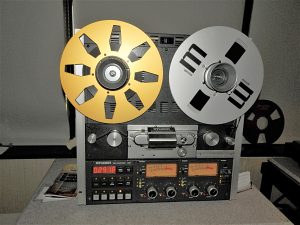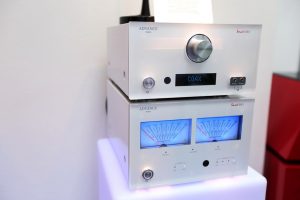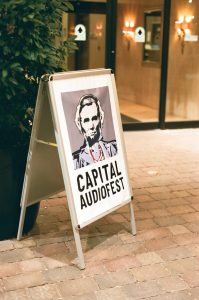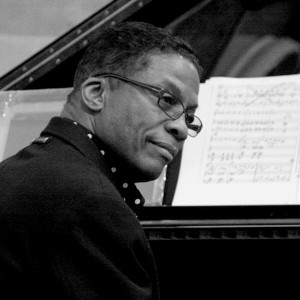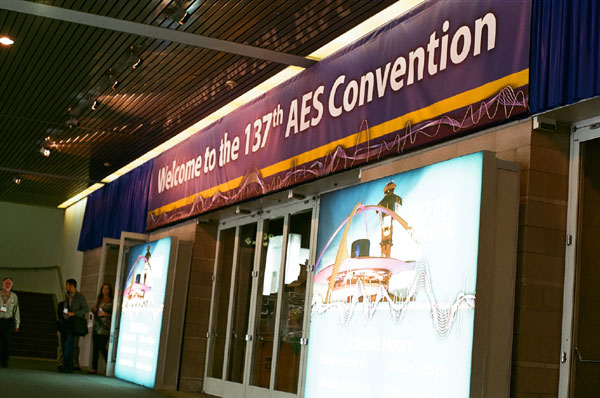
The AES show has long been two shows in one: a scientific conference in one set of rooms and a trade show in another set of rooms. What is great about the event is that although the two are often disjoint, there are people who straddle both of them. Vendors who would normally just send their sales team to a trade show send actual engineers to the AES conference and that makes it much more interesting both on the trade show floor and in the paper sessions.
For the past few years the organization has been trying to add events that are sort of in-between the two, like workshops, sessions on home studio issues, game design, and product design. I think this has been successful in getting more cross-pollination between the two groups but it has been far more so this year than in previous years. The project studio sessions were held in the main hall, but silently with the audience listening on headphones. This allowed people with free exhibits passes to attend those sessions but made it possible for them to hear the speakers over the show floor noise.
This year I saw more vendors and more attendees than I have seen in many, many years at the show. There were no huge booths; the massive EVI booth and the two-story Ampex tower are long gone, but there were an awful lot of small ones, including a lot of new companies which had never been there before.

Intro
I'll say also there were some other organizations, like the SMPTE and the SBE which were not only exhibiting on the show floor but were assisting with programming for the event as well. For the most part this worked well, although there was a "High Resolution Audio Events" track which was in part sponsored by an outside organization, which seemed more to be marketing to promote high sample rate systems than serious discussions of the advantages and pitfalls when producing high sample rate materials.
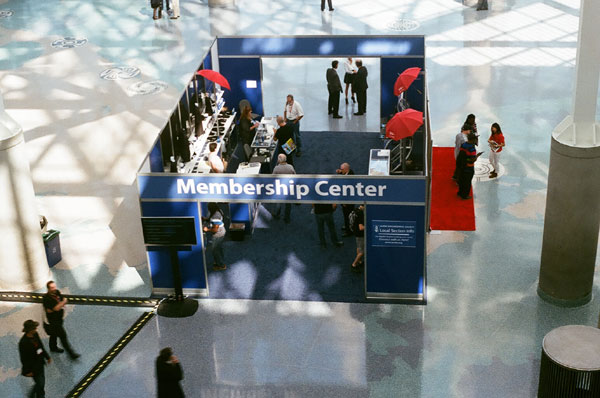
I also want to say that this is the first year that I have been to the show where no vendors, not one of them, were selling patch bays. If there is one thing that makes it clear we are now in a new age, this does it more than all the digital consoles and recorders on the show floor.
Acoustical Stuff
Flex Acoustics was showing off their Qtube system of inflatable sound absorbers for large halls. These allow a concert hall to be used for classical music which requires a reverberant hall, or a rock concert which requires reflections to be almost eliminated, or a spoken word event where something in the middle is required, simply by adjusting them in the field in a matter of minutes. Today in an era where we have far fewer concert venues and need to make the ones we have serve for more kinds of events, this is important.
Soundproof Windows, Inc. was showing a large line of steel doors and windows designed for low sound leakage and with actual measurements of sound leakage so you can predict the performance of your room before installing them. These are the sorts of things I'd love to see in more control rooms but they are also just as applicable to a well-build home listening room where you want not to hear the washing machine outside.
RealAcoustics LLC was showing their "Wave-C" bent acoustic panel which was intended for suspended ceilings and the like. A bent panel, but not regular like most polycylindrical diffusers, it looks like a very fine diffusion product for spreading ceiling reflections out. They were also selling a new panel diffuser called GUD for Geometric Uniform Diffuser which they claimed was more effective per unit area than typical diffusion panels.
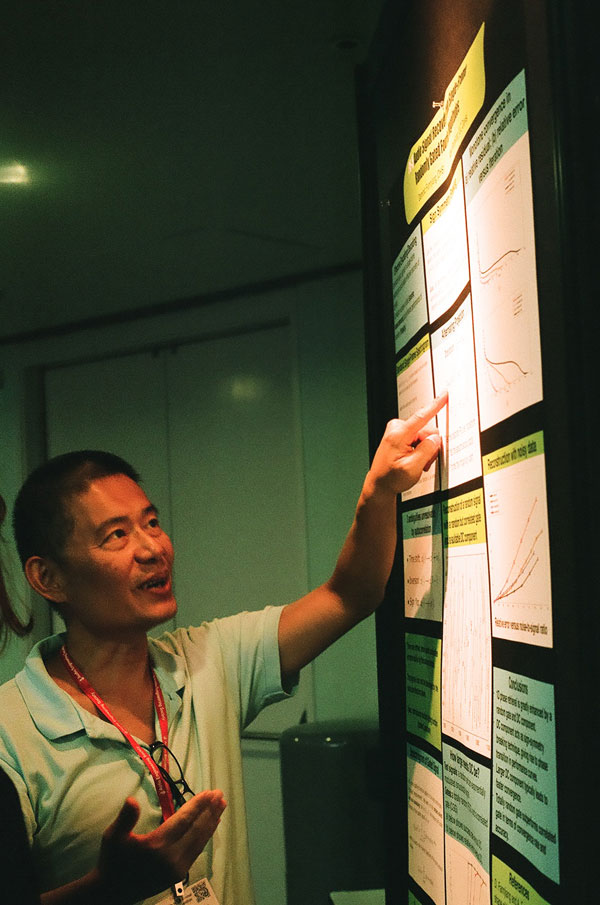
There were a lot of papers about acoustics as well. In On the Acoustics of Alleyways, Regina Collechio and many others studied alleyways bounded by flat reflective parallel walls and concrete floors and the oddly modulated reverberation they produce. At first thought, this sort of work sounds like an interesting academic exercise, but a little more thought leads one to imagine a lot of applications in outdoor sound simulation for film soundtracks and even game design. A little more thought leads to thinking about long internal corridors such as the one used by Rudy van Gelder for the very unusual acoustics of his studio. Preprint 9190.
I stuck my head into Oscillating Measurement Motion – Myth or Magic Part I by Wolfgang Hess and Stefan Varga, just wondering what it was about with such a strange name. It turns out, not surprisingly, that the frequency response inside a car is so irregular that if you want to know the approximate response at the driver's position, you can't just measure it in one place at his head, you have to actually average measurements around the head location by moving the measurement microphone around, and there are various ways of doing this but no standard. The authors established the importance of this technique but discussed different patterns for motion and what the possible standards should be like. Preprint 9159.
Visualization of early reflections in control rooms by Malcom Dunn and Daniel Protheroe was as much of a sales talk as a real paper presentation, but it demonstrated an interesting tool that takes an ambisonic signal from a room where an impulse source makes a sound, and creates a 3-d plot of the various reflections in the room and their approximate distance from the mike position. A useful technique and they provided enough information that it could be generalized beyond their particular tool. Preprint 9157.
In Subwoofers in rooms: stereophonic reproduction, Juha Backman from Microsoft in Finland performed some simulation studies of small rooms to determine that room modes can cause dramatic differences in low frequency cues, but that it is clearly possible to reproduce low frequency imaging if the room can be controlled. He specifically did not address audibility of low frequency position information, as that's the next problem down the road of systematizing accurate low end. Preprint 9145.
In addition to the papers, there were also some other presentations that touched on acoustics, like Facility Design: To Move or Not to Move? in which Eddie Kramer and John Storyk talked about two noncommercial FM broadcast stations that were actually producing new musical content and had real studios for live and recorded musical performance, and how they managed moves into newer facilities with different acoustics.
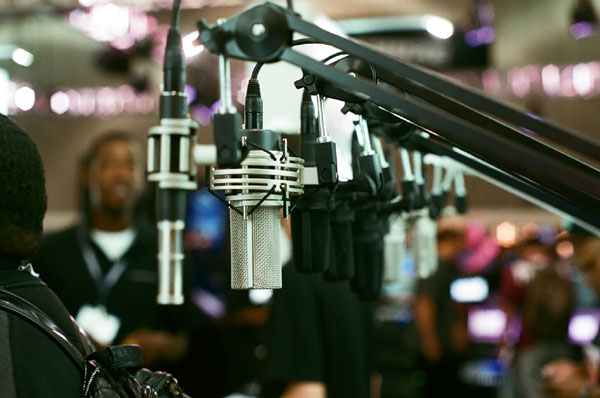
Microphones
Sand Hill is a new company in Finland making some very interesting little ribbon microphones. They seem to have a good null although the top end is a little rolled off and not very detailed. Their Sandhill 6011A appears to be voiced with a sound vaguely reminiscent of the old RCA mikes, and it definitely looks like a promising start.
DPA was selling the "d:screet Necklace Microphone" which was almost a smaller version of the traditional lavalier that hung around the neck, but this one sits very close up to the throat and has a frequency response tailored for natural voice at that location. It's a thing nobody else has made for a long time.
A company called Cliff Microphones was showing their first design, a ribbon microphone with a very powerful magnet assembly for very high output. Sadly the large magnet assembly blocked the ribbon acoustically and so the mike had hardly any null at all, a real issue for any figure-8, and it had an odd distortion issue as from unsupported wiring causing parasitic little dynamic microphones inside. But for a first attempt, it was certainly a good start and surely better than my first couple ribbon mikes were.
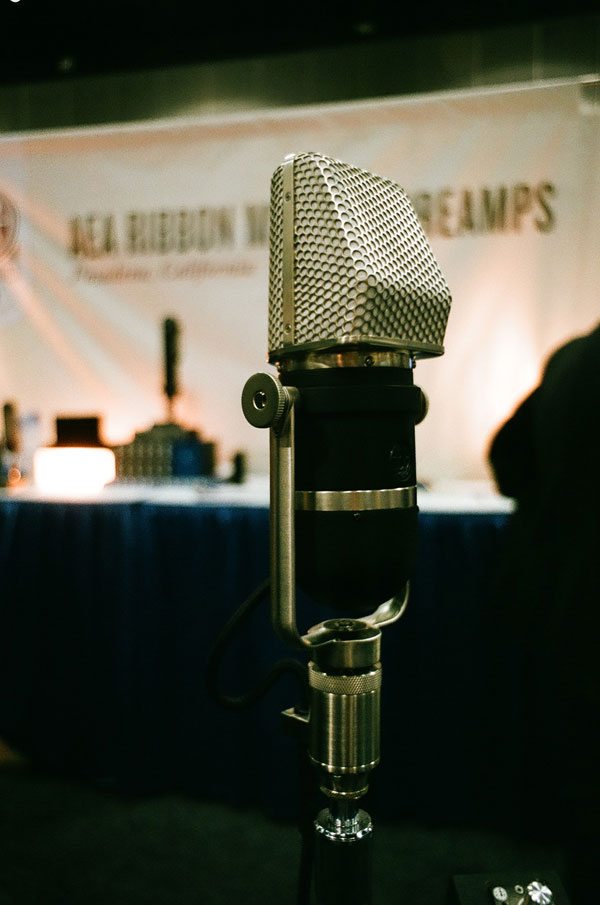
Accessory King was showing off some very inexpensive Asian-sourced shotgun microphones and a hypercardioid intended for the ENG and video market under the name Acoustic Solutions. They also had an inexpensive ribbon mike sold under the Berlant name, and it's good to see that old name coming back again.
Dave Pearlman is introducing a replica of the Church microphone. This was a design done by Stanley Church for MGM back in the 1950s using Telefunken capsules, but with very different body and grille design, and they have been something of a legend in the industry for many years. The fact that someone would even attempt this is very impressive, and Pearlman has a reputation for very fine recreations.
Audio-Technica has a few new microphones including a very odd large diaphragm mike. The AT5040 has a huge rectangular capsule that is broken up into four sections with individual rectangular diaphragms to keep the breakup modes up at higher frequencies. Designed as a studio vocal microphone, the demands of such a mike are quite different than what you might want for ensemble recording.
Soyuz was also showing a new Russian-made large diaphragm vocal mike as well as a small-diaphragm tube microphone, something not very common these days and a definite hole in the market right now that I am pleased to see them filling.

A number of companies were showing off measurement microphones. B&K and ACO were both showing their usual line of top-grade IEC Type I measurement mikes but in addition Larson-Davis (now a division of PCB Piezotronics) was at the show for the first time in my memory, with a line of similar products. Josephson Engineering was showing off both inexpensive calibrated microphones and IEC Type I mikes that they resell from Microtech Gefell.
Speaking of Microtech Gefell, Udo Wagner from Gefell was showing off a new line of T-bar microphone mounts, with a short one that could be used for ORTF, NOS, and similar near-coincident configurations and a larger one that could be used for Decca trees or similar spaced omni techniques. Precisely made, these are a big step up from the music store bars and homemade arrangements, but at a price much lower than the fancy Schoeps bars.
Another unusual microphone mount was the IsoMike, a large baffle intended to make omnidirectional microphones directional. Much like the Jeckin disc, it is physically much larger than the Jecklin configuration so that it provides amplitude directionality down to much lower frequencies, and it is in fact two planar baffles, each as tall as a man, put together for 4-channel operation. A product of Ray Kimber, I would love to have seen the actual device on the show floor, but they only had photos and (of course) audio, but it is understandable something this size would be difficult to exhibit.
In Graphene Oxide Based Materials as Acoustic Transducers: A Ribbon Microphone Application Case Study, Peter Gaskell and others from McGill University look into using aluminum-coated graphene oxide film as a ribbon microphone element. They find some physical advantages to the graphene but find that the high resistance is a major problem. Preprint 9144.
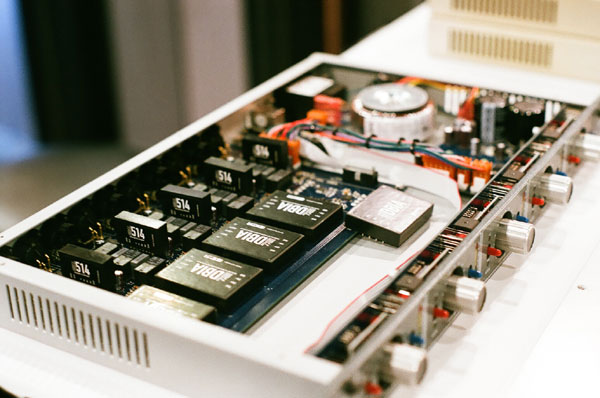
Microphone Preamps
Millennia Media has taken the electronics from their amazingly clean and quiet HV-3 and put them into a small portable case with the HV32P portable stereo preamp. I worry about the tiny little controls and the ability to set gains accurately, but you have to give something up when you make the gear this small, even if you're not giving up sound quality.
A new company from Montreal, GKL, was selling an interesting all-discrete five-channel mike preamp. Transformerless inputs, and the individual electronic stages are on replaceable potted modules.
A lot of electronics, not just microphone preamplifiers, utilize DC servo circuits in order to eliminate DC offset. In DC Servos and Digitally- Controlled Microphone Preamplifiers, Gary Hebert from THAT Semi goes through the basic math behind the servo and the tradeoffs for locating the low-pass pole for the servo amplifier. He then details a two-pole servo design with two different time constants which solves some of the issues with spurious low-frequency peaks created by a conventional servo and also speaks well of the advantages of AC coupling with a capacitor in spite of the problems that can add. Nothing new, but worth reading for anyone designing servo-decoupled electronics. Preprint 9198.
In Performance of the microphone-preamp interface, Eric Benjamin and Andrew Kimpei give a basic overview of the widely varying microphone sources and how preamps need to be designed to accommodate them. The surveys they did on distribution of microphone characteristics are excellent and worth checking out the preprint for. They omitted some important things, like a real discussion of how the load impedance on the microphone affects distortion and frequency response and is usually much higher than the source impedance. They also got a few things wrong; although the matching of phantom power resistors affects the rejection of noise from the phantom power supply, the source impedance of the microphone swamps it to the point that it has little effect on the induced noise on the microphone cable. Engineering Brief 176.
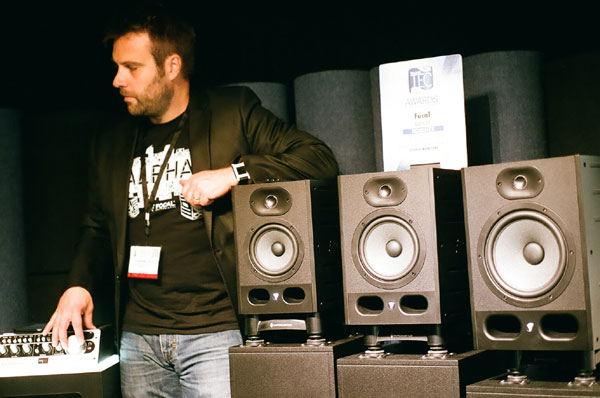
Monitor Speakers
Equator Audio which has been around for a few years making a coaxial horn monitor is now making a less expensive lower cost coaxial nearfield design called the D5. It was impossible to tell what it sounded like given the show conditions, but it's definitely a new driver design.
Chris Pelonis was showing the Pelonis model 4A dual concentric monitors. These use a modified Tannoy driver, and now that Tannoy seems to be neglecting the monitor market, these might be the best way to get that sound in a control room or even a living room.
Pro Audio LA took some folks offsite to a studio called The Realm to audition some gear, most notably the new Guzauski-Swist monitors. These are three-way tri-amplified speakers with outboard amplifier and dsp boxes sold along with them, and the sound was excellent. There were a few issues with room asymmetry and reflections off the console, but it was by far the best sounding demo I have heard at a show in many years.
Focal was getting into a lower budget level than they have previously been in, with three lower cost monitors, the Alpha 50, Alpha 65, and Alpha 80. It was hard to tell much from the demo but Focal has had a good track record in the past.
Barefoot Sound was demonstrating a tiny bookshelf-sized three-way monitor, the MicroMain 45. It was impossible to hear it on the show floor but given their previous record it should be worth trying.
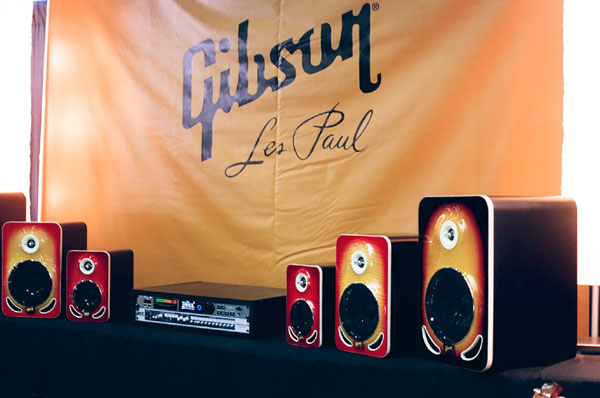
Gibson was selling a new line of monitor speakers under the "Les Paul" name with a finish reminiscent of the Les Paul sunburst guitars. Who knows how they sound? They look good, anyway.
Shadow Hills was selling a gadget called the Oculus which was a remote control monitoring unit. These days when people seldom have a large frame console, they need the monitoring features that were built into the console along with their digital system, and this gadget gives them those controls for listening and talkback, in a remote unit they can carry around the room.
There were a lot of papers about speakers, as always. It's been known since the 1940s that "flux modulation" effects exist in loudspeakers. As the position of the voice coil changes with respect to the magnets, many parameters of that coil including the inductance and impedance change also, so there is a position-dependent modulation of the signal which causes a form of distortion. In Nonlinear flux modulation effects in moving coil transducers, Felix Kochendoerfer and Alexander Voishvillo from JBL discuss the issues and demonstrate actual measurements of the effects as a function of position, current, and frequency so that the effect can be better modelled. Preprint 9162.
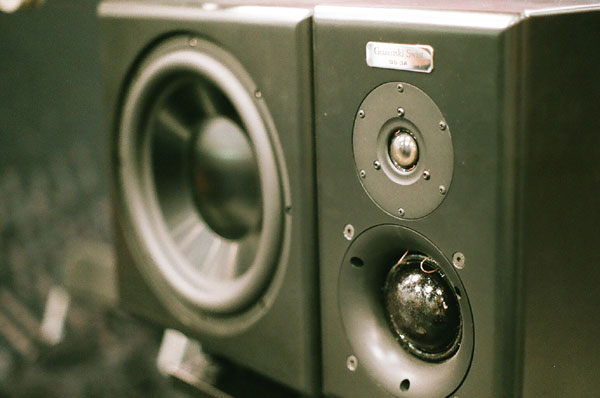
In Compensation of the flux modulation distortion using an additional coil in a loudspeaker unit, Niccolo Antonello and Finn Agerkvist from the Technical University of Denmark describe a method using a bucking coil to compensate somewhat for these effects and the results of a computer simulation, but no actual physical testing. Preprint 9160.
In Design and construction of a circular AMT speaker of 360 degree radiation, Rodrigo Arcani and Alejandro Caparros from the Universidad Nacional de Tres de Febrero in Buenos Aires detail the construction of a Heil Air Motion Transducer as a cylinder rather than as a flat plate. The original prototype is large and crude and has somewhat poor high end response, but the response is very constant with horizontal angle and it is a new design with some promise. Preprint 9163
Compression drivers employ a "phasing plug" between the diaphragm and the horn to keep the motion of the diaphragm constant and piston-like. At the 2007 AES show, Jack Ocklee-Brown from GP Acoustics demonstrated a good method for designing phasing plugs and in A Generalized Approach for the Acoustic Design of Compression Drivers with "Narrow" Channels and Rigid Diaphragms, he expands a bit more on it, and uses finite element models to verify the performance of plugs designed with this improved method. Again, nothing hugely innovative, but another important little step toward better and cleaner horn speakers. Preprint 9165.
In Multiphysical Simulation Methods for Loudspeakers-- Advanced CAE-based Simulations of Motor Systems, Alfred Svobodnik, Roger Shively, and Marc-Olivier Chauveau took an electromagnetic simulation of the speaker voice coil-magnet interactions and connected it up to a simulation of the speaker cone moving assembly (which provides mechanical resistance to the voice coil) to come up with a combined simulation whose impedance curve matches that of a real driver fairly well. Preprint 9214.
Sound Reinforcement
There used to be as much SR gear as studio gear at the shows, but in the last few years there has been less and less. This year I think there was a much greater concentration, with EAW showing their Anya G24 steerable line array. This allows a system to be flown and then the radiation pattern (sadly in only one plane) to be adjusted after the fact from a computer system on the fly, which is a great thing for touring companies that go into different rooms every day and may not have time to properly set up and map everything in advance. EAW of course didn't have a large enough room to do a full demo, but they had the system on display, and people who knew something talking about it.
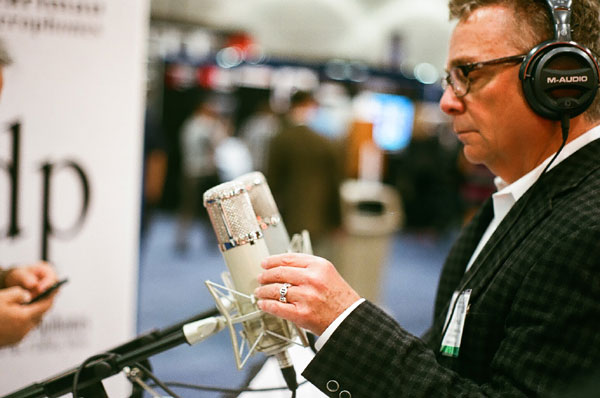
Headphones
AKG appears to have moved production of some of their less expensive models from Austria to China and sadly the fit and finish appears to have suffered a lot, with much poorer quality feel and some obvious plastic molding issues. Is there any difference in sound? It's hard to tell, but thankfully they are still making many of their models still in Austria.
On the other end, Shure is now making some very well-built over-ear headphones for consumer use, and they were showing their SRH144 at the show. It's hard to tell much at the show, but they weren't boomy and they weren't spitty, and that's a start. They still don't take their customer seriously because they were giving a "frequency range" of 30 Hz to 20 KHz, which is to say a totally meaningless number since no tolerances were implied. They are calling the things "Extended Range Audio," and who knows what that means? But in spite of the silly marketing, they still might be worth checking out.
Audeze was selling some high grade planar magnetic headphones. It was hard to tell much under show conditions except that they were very bright and forward, but they could be worth trying.
Now, we know that the same headphones sound different to different listeners for objective as well as subjective reasons; the actual frequency response as measured in the ear depends on both the ear geometry and the headphone, so the headphone is only part of the system. But there haven't been a lot of studies on variations and there hasn't been any easy way for people to pick headphones for their ears other than trial and error. In PHOnA: A Public Dataset of Measured Headphone Transfer functions, Braxton Boren and others talk about a number of academic institutions that are pooling their headphone measurements together into a single database which will be available for people wanting to do that sort of research. Preprint 9126.
On the other hand, in Effect of Headphone Equalization on Auditory Distance Perception, Kaushi Sunder and others from Nanyang Technological University in Singapore determined that equalizing headphones to a flat curve changed the perception of distance for people using those phones. This may seem obvious, but it's important to determine the degree of the effect which this study began to do. Sadly they didn't look into specific frequency ranges like the presence region, for instance. Preprint 9149.
In The Influence of Listener's Experience, Age, and Culture on Headphone Sound Quality Preferences, Sean Olive and others from Harman International played back audio over headphones to listeners in four different countries. They used equalization that simulated the sound character of three different standard headphones, and then equalization that simulated the overall response of speakers in a room (but no other attributes of speaker playback). They found people universally across all categories preferred the "simulated speaker response" curve and suggest that a standard headphone curve be created similar to it. Preprint 9177.
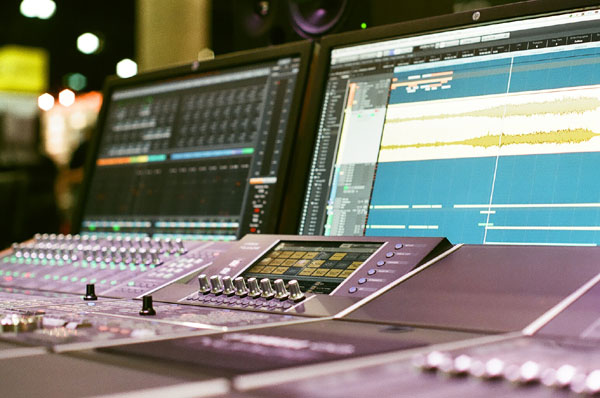
Converters
A lot of people were showing off outboard converters, and Weiss and Benchmark had all of their usual and excellent gear there. But a new company, Digital Audio Denmark, was showing a configurable A/D and D/A converter with multiple interfaces including AES3 and MADI and the ability to send both PCM and DSD data out.
Lavry was showing their Quintessence DAC, a very clean but not minimalist DAC unit with multiple outputs and calibrated volume controls. It'll take PCM rates up to 192 ksamp/sec and levels are precisely calibrated and repeatable? How does it sound? You can't tell on the show floor, but if it's anything like Lavry's other stuff it'll be great.
Tascam was introducing a line of new master clock generators, which brings high precision low-jitter clocking down to a reasonable enough price range for any studio. Their CG-1000 has the ability to re-clock a data feed against the master clock as well.
In The Audibility of typical digital audio filters in a high-fidelity playback system, Helen M. Jackson and others from Meridian Audio performed a very well-conducted test on wide-range high sample rate audio before and after low-passing with typical digital FIR filters, as would be found in CD-rate anti-aliasing and reconstruction systems, and found the filtration to be audible under good listening conditions. While I feel that the conclusion that "there exist audible signals that cannot be encoded transparently by a standard CD" is very premature, I think this points out issues with digital filter designs that need to be addressed. The introduction of oversampling and moving of much of the reconstruction and anti-aliasing filtering into the digital domain was a great advance in audio but the conclusion that such filtering is still not completely transparent seems an important one. Preprint 9174.
In A SIMULINK toolbox of Sigma-Delta modulators for high resolution audio conversions, Isacco Arnoldi and Yonghao Wang described a set of Mathworks Simulink modules to graphically demonstrate to students how modern sigma delta modulators work. Preprint 9125.
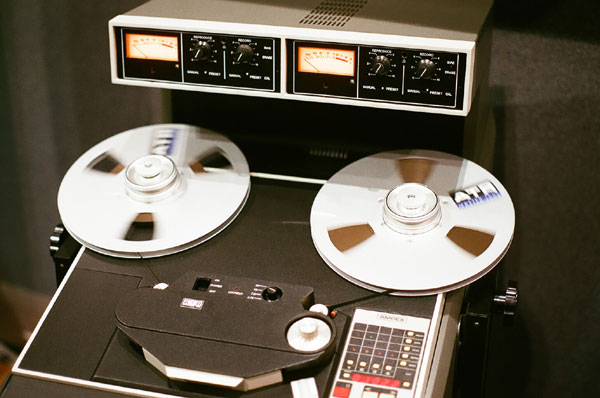
Tape
ATR Magnetics was showing off their line of very high output tape as well as modifications and retrofits for Ampex ATR-100 series tape machines.
A company called ATAE was reportedly showing off some Studer A-80 machines retrofitted with their own play-only electronics for playback of existing archive tape. However, they had no machines on display, and although I kept coming back to the booth, there was never anyone there who knew about them.

A company called Infernal Love was selling some sort of tape emulation plug in, although they claimed that they had "a tape model, not a tape machine model," and they worked to model damaged and aged tape with various controls that could be adjusted by the user to alter various parameters. The cute Goth girl was a nice touch also, although I think the inverted cross hanging in the booth may have turned off as many potential customers as it attracted. Then again, they probably know their audience better than I do.
Non-Tape
Tascam was showing an inexpensive 2-channel recorder designed for filmmakers using DSLR cameras. Built to mount directly under the camera, the DR-600DMkII does four-track recording from four balanced microphone inputs with phantom power.
Nagra was showing a line of beautifully-made precision Swiss digital recorders, most notably their magnificent Nagra Seven two-channel recorder intended for broadcast applications. It's powerful, but simple enough to use in the field under bad conditions. And it has a GSM phone built-in to send full-bandwidth digital audio back to the studio on a 3G connection.
Zaxcom was also showing some portable production recorders including their latest model Nomad combination recorder-mixer which fits in the hand but still provides high quality production audio.
Last year we saw Cymatic Audio's handheld 16-channel recorder intended for sound reinforcement folks who want to make clean multichannel recordings of concerts. This year they have the uTrack 24, a 24-track single-rack-space digital recorder that can be built into a rack with the rest of the PA gear.
LOUDAHOLISM
In Making Audio Sound Better One Square Wave at a Time, Leif Claesson from Omni Audio gave a good description of the history of the loudness wars and the issues resulting when clipped recordings are put through the broadcast air-chain. He then gave a very good demonstration of the "undo" function incorporated in the Omnia9 broadcast processor, and how it basically interpolates data and fills in the missing information on clipped peaks. Of course, once data is lost, it can never be regained, but it appears that guessing about what has been lost can achieve considerable improvement, even if never the proper reconstruction of the original. Sadly, although the paper was subtitled How an algorithm called "Undo" fixes audio, the author never actually talks about any of the details of how it works. It was good to see this exists, but I'd like to know more about what is going on inside the box than a glorified sales presentation. Preprint 9202.
Hypercompression has become such a common thing that a large number of listeners prefer extremely compressed and limited material in listening tests. In Factors influencing listener preference for dynamic range compression, Malachy Ronan, Robert Sazdov, and Nicholas Ward from the University of Limerick surveyed existing research on listener preference, and detailed what experiments need to be performed in the future to see exactly why this is the case and how exposure to material changes listener tastes. This isn't a research paper, but an important look at what research is needed. Preprint 9176.
Components
Schurter is known for IEC power plugs and fuse holders and the like, but they also turn out to make a variety of phone plugs and switches as well. Very high grade German stuff.
Electroswitch was also there, showing a large line of switches and controls including some excellent concentric rotary switches. These are almost unavailable these days but they are necessary for many traditional designs when you need to minimize panel real estate but still have one control per function.
NKK was showing off some switches as well, including a line with tiny video monitors built into each button so that not only could icons be displayed on the button to indicate what it does in a given mode, but actual realtime video feeds.
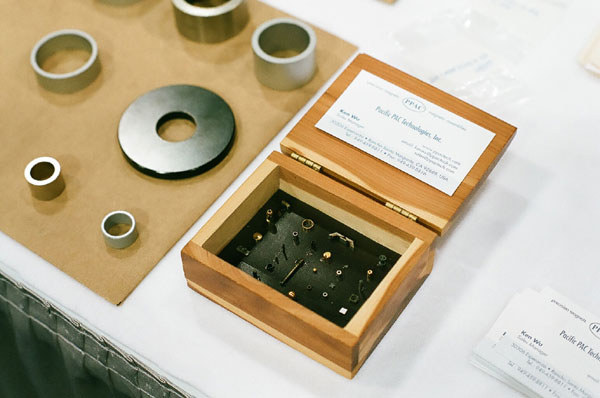
Pacific PAC Technologies was showing a line of permanent magnets, presumably with the intention of selling to speaker manufacturers at the show.
There were no semiconductor companies on the floor this year, surprisingly enough! That was a real shock. But there were plenty of papers about semiconductors.
Robert-Eric Gaskell from McGill University talked on Modeling the Nonlinear Behavior of Operational Amplifiers. He built some simple digital models of op-amps whose harmonic distortion spectrum was identical to that of some commercial monolithic opamps. Now, just because the harmonic distortion spectrum is the same does not mean that the transfer function is the same; there are plenty of nonlinear effects that will show identical harmonic distortion spectra while being essentially different. So, he did listening tests to compare his models with the actual opamps modelled, and he did this in a proper and well-controlled way. This tells is something important about the importance of different distortion effects in op-amp design, as well as giving us a useful simulation model. Preprint 9206.
Digital models of vacuum tube devices have evolved quite a bit in the past thirty years, but for the most part the effort has been putting into making them accurate over the linear region where tubes are most often used in RF and hi-fi applications. These models often fall apart when used to model guitar amp circuits that are frequently used in saturation. In Triode Emulator – Part 2, Dimitri Danyuk adds to an existing computer model by allowing it to simulate the varying grid impedance that happens when triodes are run into severe overload. For normal hi-fi circuits, we just assume that the input is a pure capacitance, but for a circuit used in clipping you need to take it into account. Preprint 9124.
Product Design Sessions
There was a track of presentations for product designers that was very interesting. In The Secrets of Analog Design, a panel of Dave Derr, Dave Hill, and Hutch Hutchison talked about a variety of wide-ranging topics. I was most fascinated by Dave Hill's pointing out that the distortion spectrum of a simple triode voltage amplifier stage at normal levels varied with the input impedance. It makes sense but it's one of those things nobody talks about.
Sadly, the Welcome to Top Gun for Product Designers presentation did not go as well, because the talk was pretty much hijacked by one speaker.
In System Engineering and Global Sourcing, Mike Klasco talked about the ups and downs of having products made abroad. He had a lot of interesting insights, like looking at the rework line rather than the production line and seeing what is coming back and/or falling out of the production tests. He talked about fake Kapton adhesives, and how one company was mystified that they had to use a larger voice coil to get the same performance when they moved to China because they believed the factory when they said they were using the correct high-temperature adhesive. How long have engineers been at the factory? Five years is a long time in a country where people frequently leave one factory for another and take designs with them. Will the factory let you look inside their tool room and see the designs they make? Will they let other people look inside there and see your designs? Are you sure you want to make anything there? Do you want to hire a trading company or not? It was a very interesting talk.
Amplifiers
Every year there are more and more Class D amplifier papers, and this year was no exception. As time goes by, I lose what little interest I have had in class D amplifiers, but there was one pair of papers I wanted to check out. In A Direct Driver for Electrostatic Transducers, Dennis Nielsen, Arnold Knott, and Michael A.E. Anderson detail a class D amplifier with very high voltage rails designed to directly drive electrostatic loudspeakers. The same folks gave another paper, Comparative Study of Si and SiC MOSFETs for High Voltage Class D Audio Amplifiers, where they detailed some of the advantages and disadvantages of the new silicon carbide transistors for high voltage switching into capacitive loads like electrostats. Preprints 9147 and 9115.
I did see Performance Comparison between Nested Differentiating Feedback Loops and the Classical Three Stage Operational Amplifier Architectures; a SPICE-based simulation approach, by Ariel Muszkat and David Kadener from the Universidad Nacional de Tres de Febrero in Buenos Aires. Since the 1970s the standard transistor power amplifier configuration which you will find in just about every commercial amplifier has been a three-stage system with a differential input, a voltage amplifier stage, and then a push-pull power amplifier stage with global feedback around the whole thing to linearize it. Unfortunately global feedback cannot deal with some types of distortion, most notably the crossover distortion which is most audible at low listening levels. The only solution for crossover distortion is to increase the bias level, and now you're wasting power and headroom. So Edward Cherry suggested in 1979 bringing back the old tube amplifier concept of multiple nested feedback loops and provided some systematic methods for setting poles and zeroes to allow greater overall feedback. The authors used some computer simulations in order to compare amplifiers designed using both approaches and the discussion is a worthwhile one for anyone designing solid-state amplifiers. Negative feedback has received bad press in the high end world due to misapplication, and a 1970s philosophy that it will cure all things, but it is a tool that can be used to do good as well as evil. Preprint 9201.
Transformers
Keen Ocean from Hong Kong was there, showing off switching supplies and transformers designed for switching supplies. They did have a 70V audio transformer on display but nobody there seemed to know much about it and when I asked about whether they could make wideband output transformers they didn't seem to know much about that. They seemed like good people, but they also seemed like they were at the wrong show.
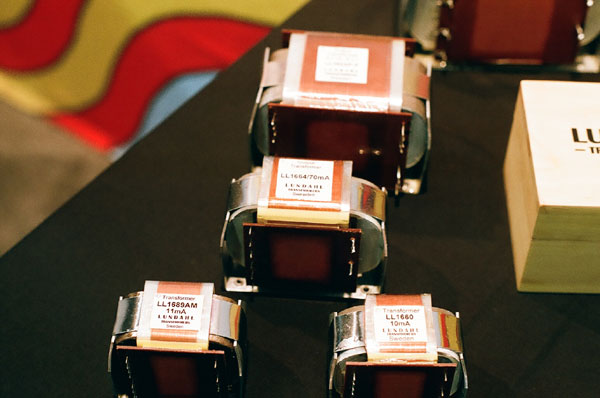
Lundahl was there, though, and they definitely have aimed hard for the pro audio market. They were showing off a new mounting for an old design, with their 1527 line matching transformer built into a DIN rail package with screw terminals for easy setup by installed sound people. Want a home theatre system that doesn't hum? This is the product for that.
Cables
Belden was showing Cat6a cable, including patch cable, for use in the new 10G Ethernet systems. They had plenty of their standard audio products as well.
Corning was there selling optical cables with built-in transceivers for Thunderbolt and for USB connections up to 200 feet or so. A big deal in a world where people want to have their noisy digital workstation in one room and their speakers, keyboard, and computer monitor in another.
Probably the most interesting new cable this year was Grimm Audio's low microphonic noise cable. This is a twisted pair balanced audio cable made with a conductive plastic sheath to prevent handling noise from tribolectric charges, but it also has an external shield rather than using that plastic sheath as part of the shielding. Triboelectric noise is not normally a big issue for professional audio applications because we use very low impedance connections in most cases. But for things like ribbon microphones and electric guitars, the high source impedance can turn it into a problem especially in a stage situation where cable is being constantly moved. So rather than being a lot of flaky stuff, this is a serious move to solve a real problem.
Wireless
The opposite of cables is wireless. Airnetix was showing off some multipoint digital systems that allow full bandwidth uncompressed digital audio to be sent around on 2.4 GHz links. This could be a good thing for delayed speakers at outdoor festivals, for feeds of the main speakers to backstage areas, and the like. I'm a little wary of doing anything critical on the 2.4 GHz ISM bands since they are far from interference-free, and, of course, you have no more right to the spectrum than anyone else does, and no recourse if interfered with. But there are plenty of noncritical applications at festivals and the like where this could be very useful, and I'd love to see a licensed version.
Testing
Probably the most interesting test device at the show (and a runner-up for silliest name) is the ANNA-LISA device from DirectOut. They are German, so they pronounce that name "Anna-Liza," which is supposed to sound like "Analyzer," which is, in fact, what it is with respect to MADI systems. It is a complete MADI analysis tool with BNC and optical inputs and outputs, and USB and Bluetooth interfaces that allow it to connect to a host computer. The thing is, the gadget fits in your hand, which means you can just toss it into the kit when you go out into the field, or keep one in your pocket when you go to a studio. It looks to be a lifesaver for diagnosing mystery MADI routing problems, but also will produce test signals over the MADI buss for diagnosing both digital and analogue systems.
Avermetrics was selling a test and measurement system, sort of a cross between the Audio Precision bench top tester, and the big Agilent automatic production testing systems. It's designed to do a lot of repeated response and distortion tests very quickly on a small production line at a reasonable cost, and it's built with scalable modules so it can grow with the complexity of a small manufacturer's product. In a day when so much stuff is being made abroad and acceptance testing has become necessary to check up on foreign contractors, this can be a lifesaver.
Hill Acoustics was showing small tetrahedral test chambers for loudspeaker testing. Their brochure was curious at best and it was somewhat difficult to see the point of it over any other fixed-volume chamber for quality control but it's good to have standards.
It's common to estimate speech intelligibility of a room by playing back audio of standard speech recordings back through the room (with or without a sound system) and either listening or measuring the results. The problem is that the radiation pattern of the playback speaker is not the same as that of a human being talking, and this can affect the results considerably. In Simulating Talker Directivity for Speech Intelligibility Measurements, Peter Mapp makes some attempt to quantify the problem and provide some possible solutions. Preprint 9156.
Distortion tests don't measure the nonlinearity of a device, they only measure the symptoms of the nonlinearity, so it becomes difficult to fully characterize a device. In Measuring Time Varying or Offset Voltage Dependent Harmonic and Intermodulation Distortion via Filter Banks Including a Starstep Signal and Measuring FM Distortion in IM Distortion Signals, Ronald Quan demonstrates a new set of tests for determining HD and IMD on varying signals, as well as a similar test for determining FM distortion caused by changes in phase response with signal that can be characteristic of some FET designs. Preprint 9197.
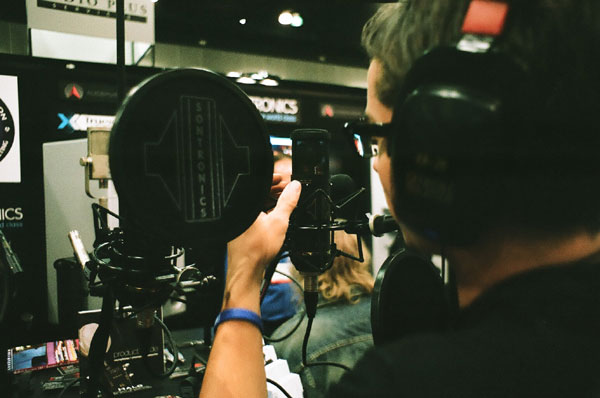
Listening
It's well-known that people can get used to spectral changes in loudspeakers over a very short time period, and that effect has been very well measured and quantified for speech signals. However, nobody in the past has done much to quantify the effect for music. In Auditory compensation for spectral coloration, Cleopatra Pike and others from the University of Surrey do just that, and this sort of information is very important to help us conduct accurate listening tests in the future. Preprint 9138
In Listener preferences for analog and digital summing based on music genre, Eric Tarr and others from Belmont University took some multitrack recordings and mixed them with the final bus summing, done either digitally or in the analogue domain after individual track D/A converters. Listeners in general preferred one or the other, and their preference was dependent on the genre of music. This establishes first of all the existence of audible differences between summing systems, and the validity of using those differences for artistic reasons. Preprint 9136.
Recently, Mikko-Ville Laitinen and others from Aalto University in Finland had found that the relative phase between a bass component and higher frequency components affects the perceived level of the bass on recordings. In Effect of phase on the perceived level of bass they determine what waveforms produce the loudest perceived sound and softest perceived sound for a given measured signal level, but they also observe very interestingly that the effect is not always the same between different listeners. This means two people might disagree over low frequency balances in the same recording or playback, and both be right. How can we compensate for this? How can we use this to produce dance music with louder bass? These questions are only beginning to be answered. Preprint 9137.
In Pathways Through Recording Analysis, William Moylan from the University of Massachusetts talked in a philosophical manner about how we listen critically to recordings, and the different possible pathways we can take for listening to different aspects of the whole. Preprint 9103.
Oddities
Dramastic audio was showing an automation computer replacement for SSL model 4000, 6000, and 8000 consoles so people can get rid of those 8" floppy disks. Audio gear outlasts computers and so retrofits like this become an important way to keep automated systems running.
A lot of folks had equalizers at the show, but Burgess MacNeal from Sontec and ITI Audio was back for the first time in years. Rumors of his demise and the demise of Sontec are untrue, and he swears that he always answers the phone when it rings. Anyway, he makes some of the greatest, most transparent mastering equalizers out there, which have become legends in the industry.
SKnote in Italy was selling a gadget that fit into a 500-series enclosure called the "AVE Vocal Enhancer and Doubler." Consisting of a Dolby A encoder and a digital delay, it provides the two typical gadgets that have traditionally been used for making pop vocals forward and broad in a single box.
Auro-3D was showing a multi-channel playback system for film use. It was hard to tell how it sounded given the somewhat gimmicky mixes they were playing back. The lip-synch was off by at least two frames too. Why doesn't anyone care about proper synch anymore?
In Headstock Resonances in the Electric Bass Guitar, Bryan Martin and Goran Petrovic from McGill University take a bass guitar and put it on an improvised shaker table using the parasitic cabinet vibration of a loudspeaker combined with a clip-on piezo sensor for feedback, and measure waterfall plots (frequency response vs. decay time as a 3-D plot) of various instruments. They find a very rough correlation between the distribution of resonances with perceived quality. This is an example of some excellent preliminary work being done with minimal equipment and facilities and it shows very much the way toward additional research possibilities. Preprint 9212.
There was a panel called Authentic Replication and Modelling of Vintage Gear, with a variety of people who made hardware replicas of old gear, software replacements for that gear, and modern hardware designed after old gear. A very interesting discussion between some top designers who probably wouldn't normally be together.
Publications
The guys from Sound on Sound were there, and that's one of the few magazines today that actually does real measurements in their reviews. They aren't as detailed as they were a couple decades ago, but they are making some real attempt at doing more than just acting to promote products. Perhaps being run by a UK publisher causes some of that.
About the only other magazine that spends that kind of effort on reviews is Resolution magazine, which is another British publication. They also had folks at the show and I was pleased to see them there.
AudioXpress was notable for their absence, although editor Joao Martins was briefly spotted on the show floor. But both Voice Coil and AudioXPress were being given out.
FOH and Live Sound magazine had folks there, as did Pro Audio Review. And there were a couple new magazines I'd never heard of before: Music Festival Business (a thin but great magazine oriented toward larger music festivals) and Sound and Picture (a production magazine that has apparently been around for a while but escaped my notice).

Conclusion
This has definitely been a larger AES show than the past few years, both on the papers side and on the trade show side, and the attempt to get some cross-pollination between the two with panels definitely seems to be working. It was a good show, maybe a little too big even. We'll be back next year.









